Second Lieutenant Harlan E. Rugg
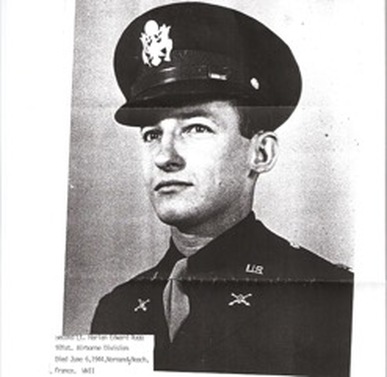
- Unit: 101st Airborne Division, 81st Anti-Aircraft Battalion
- Service Number: O-1049325
- Date of Birth: November 30, 1921
- Entered the Military: December 17, 1941
- Date of Death: June 6, 1944
- Hometown: Fairfield, Connecticut
- Place of Death: near Sainte-Marie-du-Mont, France
- Award(s): Purple Heart
- Cemetery: Plot C, Row 4, Grave 25. Normandy American Cemetery, Colleville-sur-Mer, France
Mentored by Mrs. Lisa-Brit Wahlberg
The Master’s School
2014-2015
Early Life
Harlan E. Rugg was born in 1922 in Fairfield, Connecticut, to parents Edward Harlan and Victoria Rugg. He had a twin brother, Walter, an older sister, Finette, and a younger brother, Robert.
The Rugg family had a long history of military service, starting with Harlan’s grandfather in the Civil War. Captain Harlan P. Rugg, whom Rugg was most likely named after, served in the Union Army and his journal is currently on display at the University of Connecticut. Rugg’s father, Edward, served in World War I. On September 16, 1940, Edward took his engineering experience and re-enlisted in the Coastal Artillery Corps, serving as a master sergeant with the Connecticut National Guard.
Both Harlan and his twin, Walter, enlisted on December 17, 1941, in Hartford, Connecticut, in the wake of the attack on Pearl Harbor.
Harlan graduated from Roger Ludlowe High School. During this time, he was very involved in the arts, participating in the Glee Club, A Capella Choir, and Photography Club.
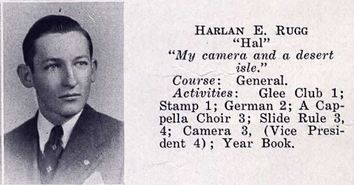
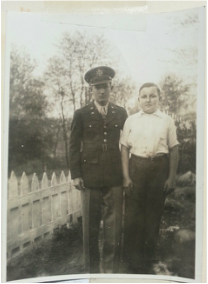
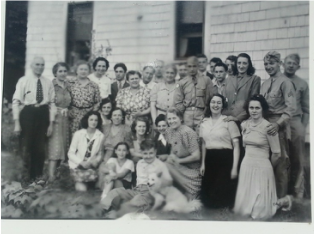
Homefront
World War II preparation in Connecticut did not start until the bombing of Pearl Harbor. However, after this, Connecticut realized its vulnerability and mobilized its factories and population. Connecticut built back its air defenses. Although no air attack materialized, the threat of devastation, as seen in London, sparked enough fear that people began to leave the city. During World War II, Connecticut saw much of its population move from urban areas into suburban neighborhoods, many of which still exist today.
When the United States entered the war, Connecticut became a shipbuilding hub, producing and repairing many Coast Guard and Navy vessels at the port cities such as Mystic, New Haven, and Waterbury. Other cities such as Groton and New London became leading producers of specialized submarines. In Waterbury’s case, the local industry enabled the people to support the war effort through purchasing war bonds.
Connecticut also housed six major airfields during the war. Companies such as Pratt and Whitney received military contracts to build and repair aircraft. Soon these factories were producing airplanes, gliders, and missiles to be used on the front and at training bases.
Throughout the war, people in Connecticut also planned Victory Gardens, donated foods, collected scrap metal, and purchased war bonds to fund the war effort better. Organizations such as the Women’s Land Army quickly became quite popular and provided needed resources to the front-line troops.
Fairfield also would benefit from the war, as people flocked from Bridgeport. By the end of the war, General Electric was headquartered there, and the population had grown from 6,000 to nearly 17,000 residents.
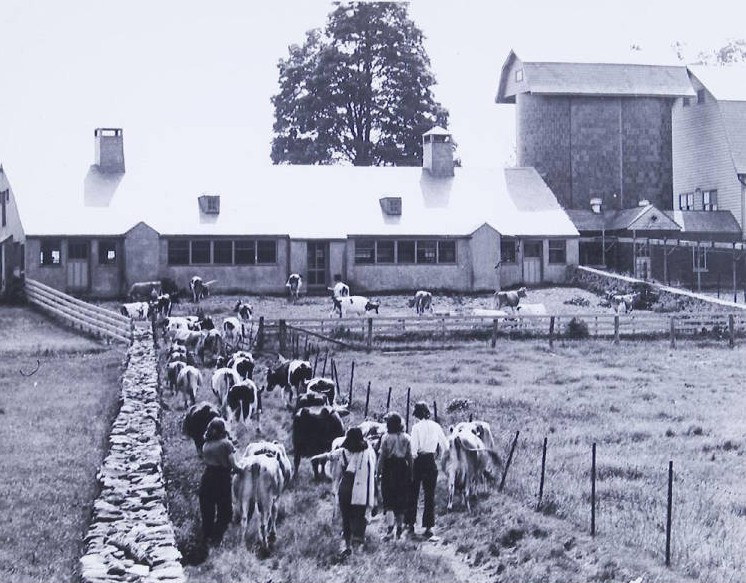
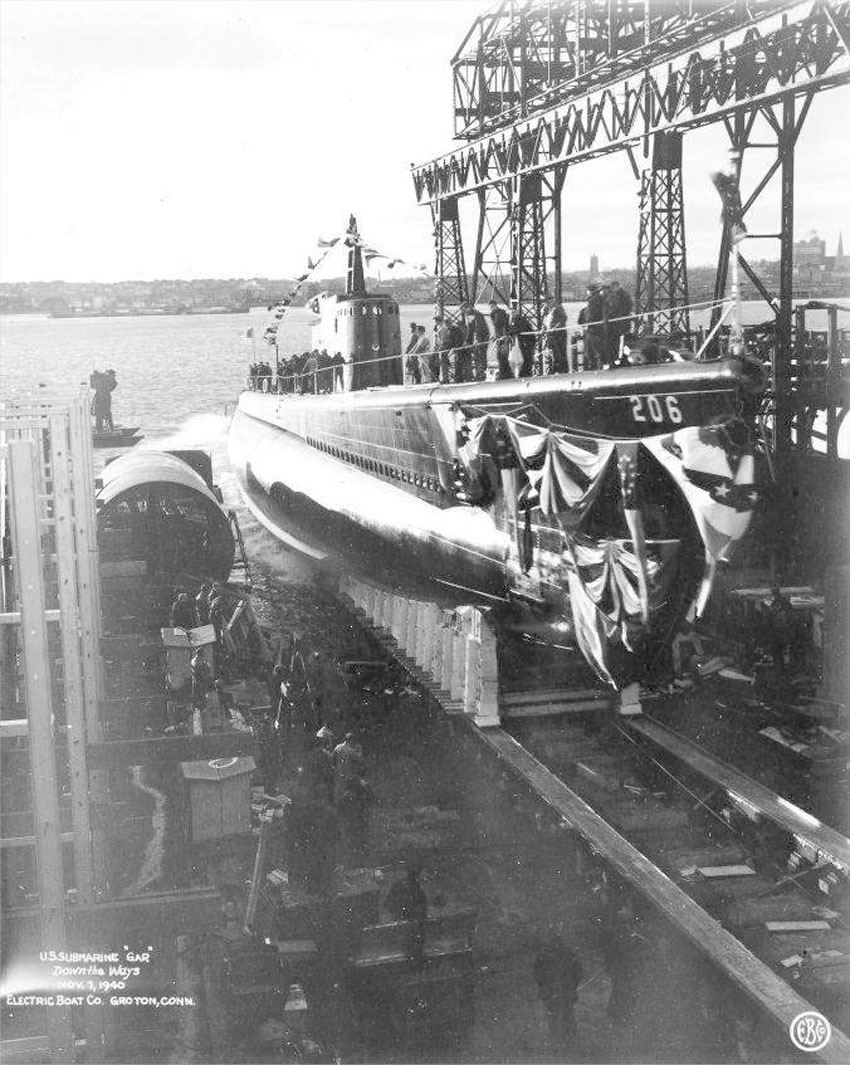
Military Experience
Enlistment
Harlan Rugg enlisted on December 17, 1941, with his twin brother in Hartford, Connecticut. Initially, he served in the Coastal Artillery, on September 29, joined the 81st Anti-Aircraft Artillery Battalion of the 101st Airborne Division. He trained at Fort Bragg, South Carolina. On October 5, 1942, Rugg participated in a two-week-long Anti-Aircraft School in Camp Davis, North Carolina, during which his battery suffered no training accidents.
On September 5, 1943, the 81st Anti-Aircraft Artillery Battalion boarded the H.M.S. Samaria and arrived in Bastel Park, England. Harlan was selected as a member of the battalion’s quartering party under B Battery’s Captain Adolph Gueymard. Harlan was commissioned as the Second Lieutenant of A Battery on Christmas Day 1943.
Gliders
The gliders used in Operation Overlord were constructed almost entirely of wood, which provided little in the way of protection from either anti-aircraft fire or a rough landing. It was not uncommon for gliders to crash and kill the entire crew. Despite these hazards, the glider’s ability to transport artillery and anti-aircraft guns, which paratroopers could not carry, made them invaluable as support troops for the lightly-equipped paratroopers.
As a second lieutenant, Rugg would have either been an assistant Executive Officer of B Battery or acted as a forward observer. Being part of the 81st Anti-Aircraft Artillery Battalion, Rugg would have had basic infantry training. From records, he went to a two-week anti-aircraft school in which he excelled at identifying the enemy and allied aircraft. In battle, Rugg would have directed the artillery support, mortar fire, anti-tank weapons, and anti-aircraft guns.
D-Day
In preparation for the Normandy landings, the 81st Anti-Aircraft Artillery Battalion was attached to the VII Corps at Weston Super Mare on April 6, 1944. Rugg and his unit participated in Operation Tiger, where they were reviewed as operating at a high state of efficiency.
Rugg departed in a Waco glider from Aldermaston, England, and landed at 3:54 a.m. as part of the 327th Glider Infantry Regiment. His mission, part of Operation Chicago, was to capture and hold the town of Sainte-Marie-du-Mont. However, after a successful landing, Rugg was shit while bending down to pet a dog.
The 81st Anti-Aircraft Artillery Battalion provided anti-aircraft fire for the remainder of the invasion and later participated in Operation Market Garden and the Battle of the Bulge.
Eulogy
Harlan Edward Rugg was one of the thousands of young men tasked with accomplishing goals against impossible odds. Harlan grew up in a small town in Connecticut named Fairfield. As a child, he would have grown up in a household filled with a history of service and sacrifice for their country, dating back to the Civil War. Harlan grew up with a twin brother, Walter, and two other siblings, Robert and Finette. His father served in World War I and later invented devices such as the bazooka trigger and the towline indicator box for gliders. Further back, Harlan’s grandfather served as a captain in the Union Army and kept a journal, which is regarded today as one of the best accounts of the American Civil War. With this family history, Harlan and his brother would have understood the meaning and vitality of military service from an early age.
In high school, Harlan was constantly involved in activities ranging from Glee Club to producing and editing his senior yearbook. After graduating school, Harlan went into the chemical business, while his brother, Walter, seems to have become an aspiring actor. However, for both twins, the attack on Pearl Harbor on December 7, 1941, inspired their preexisting sense of duty and patriotism, resulting in both Harlan and Walter enlisting together on December 17, 1941. Here, Harlan entered the Coastal Artillery as a private, then volunteered for the 81st Anti-Aircraft Artillery Battalion, which was activated on September 4, 1942.
Before being commissioned as an officer, Harlan served as a leader throughout his training and achieved the rank of sergeant during 1943, exemplifying his abilities as a leader and outstanding soldier. Rugg sailed to Britain. Upon landing, he helped lead a quartering party to Bastel Park in the fall of 1943. For his leadership and dedication, Rugg was commissioned at the rank of second lieutenant in the 81st Anti-Aircraft Artillery on Christmas Day, 1943.
On D-Day, Rugg was shot by a German while bending down to pet a dog. While it is impossible to predict what would have happened if Harlan had survived and fought on, I feel safe assuming that he would have proved to be a sure and inspiring leader for his men in battle. In death, Rugg became a rallying force for his unit and an encouragement to carry the fight to the enemy.
Second Lieutenant Rugg’s life ended almost as soon as it had begun, and like the short flash of light from a flare, it burned brightly but was extinguished in the blink of an eye. In this sacred soil, it gained at such a high price that we can see the depth of his sacrifice for his country, comrades, and indeed for the people back home. Harlan’s death would have shocked not only his family but also a young girl named Dorthy McDowell, whom we believe may have been Harlan’s sweetheart back home. In a family photo album, I saw Harlan with both Dorthy and his family, and it became clear to me that Harlan was a center of life and energy to all those around him.
To me, Harlan Edward Rugg symbolizes the patriotism that propelled the United States’ youth into fighting not only against the evils of tyranny but for the promise of freedom and liberty. Harlan fought like his forefathers before him, not for himself but others both at home and abroad. When Harlan made the ultimate sacrifice, it was for all of us gathered here today, for those who have come before us and those who will be hereafter we are gone.
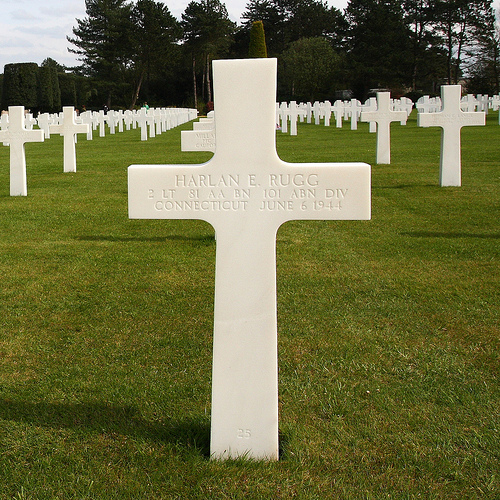
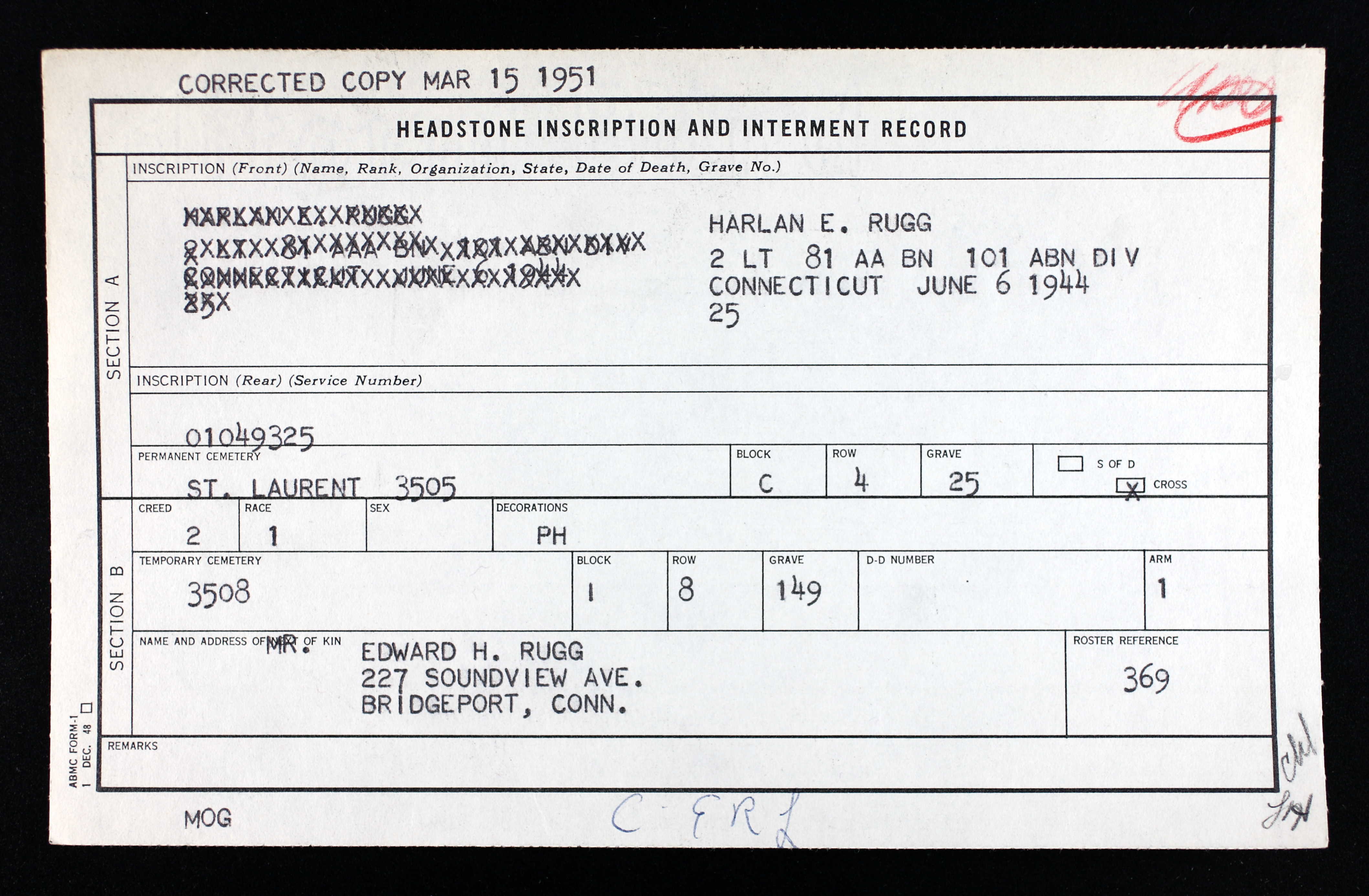
Reflection
Having the opportunity to research and meet Harlan Rugg and his family has been a moving and life-changing experience. More than any textbook and novel could ever do, the Normandy Institute and Harlan’s story has kindled inside of me a new interest in soldiers’ personal stories and lives.
I have come a long way in learning about Harlan from where I began nearly six months ago. Despite having difficulty finding records on Harlan, the big breakthrough came by re-examining his census records. Through these, I discovered that Harlan was not just a normal enlistee but also another military service chapter in the Rugg family. Both his father and grandfather had served in the United States Army in the Great War and Civil War, respectively, with his grandfather writing an extensive account of his time spent in the Army. There is no doubt in my mind that this history of service to their country compelled both Harlan and his twin brother, Walter, to enter the Army when their country was attacked.
Coming from a military family myself, it does not surprise me that Harlan and Walter were among the first to volunteer to protect and service their homeland. Doubtlessly, Harlan had grown up listening to his grandfather and father’s recounts of battle and knew when he enlisted that there was a chance that he might not return. In my opinion, this possible realization early on only increases his courage, as shown in his being in a glider battalion. Being in a glider might have been one of the most frightening and dangerous places of any war, but Harlan forged on ahead and rose to the rank of Second Lieutenant by merit, no small feat in the military.
Harlan is a true embodiment of America’s fighting spirit by his courage in the face of the enemy and his urge to protect his country and innocents abroad. With Harlan’s death, the Rugg family lost not just a brother but a foundation, a friend, and, for Walter especially, a companion. I cannot begin to understand the loss suffered here, and so the least I can do is to bring his memory and story to others so that he and his heroism remain remembered.
While there is nothing that will fill the losses of Harlan and the millions of other young men, whose lives were ended just as they were beginning, it is my sincerest hope that this sharing of his story can start to repay the sacrifices made by this Great Generation.
Bibliography
Primary Sources
Connecticut. Fairfield County. 1930 U.S. Federal Census. Digital images. ancestry.com.
Connecticut. Fairfield County. 1940 U.S. Federal Census. Digital images. ancestry.com.
The Connecticut Women’s Land Army. Photograph. Thomas J. Dodd Research Center, University of Connecticut Libraries.
Edward Harlan Rugg. World War I Draft Registration Cards, 1917-1918. Digital images. ancestry.com.
Edward Harlan Rugg. World War II Army Enlistment Records, 1938-1946. ancestry.com.
Edward Harlan Rugg. World War II Draft Registration Cards, 1942. Digital images. ancestry.com.
Harlan Rugg. Photograph. 1940. Roger Ludlow High School yearbook.
Harlan E. Rugg. Headstone and Interment Records for U.S. Military Cemeteries on Foreign Soil, 1942-1949. Digital images. ancestry.com.
Harlan E. Rugg. World War II Army Enlistment Records, 1938-1946. ancestry.com.
Launching of the submarine Gar, Groton, Connecticut. Photograph. November 7, 1940. United States Navy Submarine Force Museum.
Rugg Family Photographs. Courtesy of Rollie Wrightman.
Walter B. Rugg. World War II Army Enlistment Records, 1938-1946. ancestry.com.
Walter Baron Rugg. World War II Draft Cards, Young Men, 1940-1947. Digital images. ancestry.com.
Secondary Sources
“2Lt Harlan E ‘Hal’ Rugg.” Find a Grave. Updated August 8, 2010. Accessed March 26, 2021. www.findagrave.com/memorial/56649477/harlan-e-rugg.
“The 81st Airborne Anti-Aircraft Battalion (AAA) – Roll of Honor.” The 101st Airborne in World War II. Accessed March 26, 2021. www.ww2-airborne.us/units/81/81_honor.html.
“The 327th Glider Infantry Regiment.” The 101st Airborne in World War II. Accessed March 26, 2021. www.ww2-airborne.us/units/327/327.html.
Ambrose, Stephen E. Band of Brothers: E Company, 506th Regiment, 101st Airborne From Normandy to Hitler’s Eagle Nest. New York: Simon and Schuster, Inc., 1992.
Burns, Ken and Lynn Novick, Directors. The War. PBS. 2007.
“Harlan E. Rugg.” American Battle Monuments Commission. Accessed March 26, 2021. www.abmc.gov/decedent-search/rugg%3Dharlan.
Koskimaki, George E. D-Day With The Screaming Eagles. New York: Presidio Press, 2006.
Stokesbury, James L. A Short History of World War II. New York: Harper, 2001.
A U.S. Army Air Force Waco CG-4A-WO glider… Photograph. 1943. National Museum of the U.S. Air Force (060505-F-1234P-004). commons.wikimedia.org/wiki/File:Waco_CG-4A_USAF.JPG.
“World War II.” Connecticut History. Accessed March 26, 2021. connecticuthistory.org/topics-page/world-war-ii/.

